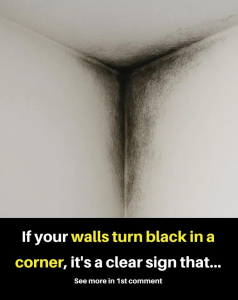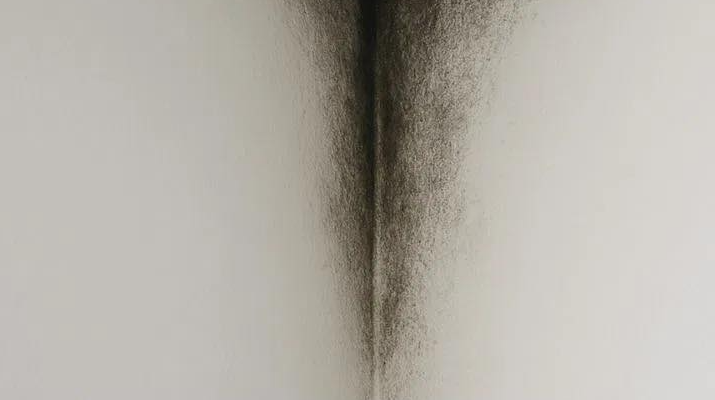
If Your Walls Are Turning Black in a Corner, It’s No Accident: What It Really Means (and How to Fix It)
Few things are more unsettling than noticing that your once-clean walls are developing dark stains—especially in the corners of a room. At first glance, it may look like dirt, dust, or just bad paint. Some homeowners even try to scrub it away or cover it with a fresh coat of paint. But if your walls are turning black in a corner, it’s not an accident. In fact, it’s often a clear sign that something deeper is happening within your home.
This isn’t just about aesthetics—it could be a signal that your house is dealing with moisture, mold, poor insulation, or even air quality issues. Ignoring it can lead to health risks, structural damage, and repeated frustration when the black stains keep returning. Let’s dive into what this really means and, most importantly, how to fix it.
Why Corners Are Most Affected
Corners of rooms tend to be more vulnerable than flat, open wall spaces. Here’s why:
-
Poor Air Circulation – Corners often trap stagnant air, making them prone to condensation.
-
Thermal Bridges – These are areas where heat escapes more easily, often at joints or where walls meet, making those spots colder than the rest of the surface.
-
Moisture Buildup – When warm indoor air hits a cold surface in the corner, condensation forms, creating a perfect breeding ground for black mold and mildew.
-
Dust Accumulation – Dust particles can settle and cling to condensation in corners, leading to dark discoloration.
In short, corners are natural weak spots where temperature differences and moisture combine—creating the perfect recipe for black stains.
The Usual Suspects: What Black Stains on Walls Really Mean
When you see black patches forming in the corners of your walls, several common causes might be at play:
1. Mold Growth
This is the most serious possibility. Black mold thrives in damp, poorly ventilated areas. If your wall feels damp, smells musty, or the stain looks fuzzy or textured, mold is likely the culprit. Left untreated, mold can spread, damage drywall, and trigger health issues such as coughing, allergies, skin irritation, or even breathing difficulties.
2. Soot or Smoke Stains
If you use candles, a fireplace, or have a furnace issue, the soot particles may settle on walls—especially in corners where airflow is weakest. Over time, this can leave a black, powdery coating that looks like mold but feels dry to the touch.
3. Condensation and Dust
Sometimes, it’s not mold or soot but a mix of moisture and everyday dust. Humid air condenses on the cooler wall surface, trapping airborne particles that cling and form dark streaks or patches.
4. Poor Insulation
When insulation is inadequate or uneven, certain wall areas (especially corners) become much colder than others. These “cold spots” draw moisture, leading to dampness and eventual staining.
5. Structural Leaks
In some cases, black stains may be the result of hidden leaks. Water seeping in from the roof, window frames, or pipes can dampen the wall and eventually discolor it.
How to Tell If It’s Mold or Something Else
Not every black stain is toxic mold, but it’s important to distinguish between them:
-
Texture: Mold looks fuzzy, slimy, or spotty, while soot is usually powdery and easily smudges when touched.
-
Smell: Mold often produces a damp, earthy odor. Soot has a more burnt smell.
-
Location: Mold tends to form in humid areas—bathrooms, basements, kitchens—while soot may appear in any room where candles or fireplaces are used.
-
Spread: Mold patches grow irregularly, while soot may create more uniform streaks or coatings.
If you’re unsure, you can buy an inexpensive home mold test kit or contact a professional for inspection.
Why You Shouldn’t Ignore It
Brushing off black wall stains as “just dirt” can have serious consequences. Here’s why:
-
Health Risks – Prolonged exposure to mold spores can trigger respiratory problems, headaches, fatigue, and worsen conditions like asthma.
-
Structural Damage – Mold eats into drywall, wood, and wallpaper glue, weakening walls over time.
-
Recurring Problems – Even if you paint over it, the stains will return unless the root cause (moisture, soot, poor insulation) is addressed.
-
Property Value – A moldy home is harder to sell and may require costly remediation before closing a deal.
How to Fix the Problem
The good news is, black wall stains can be treated and prevented. Here’s a step-by-step approach:
Step 1: Identify the Source
Before cleaning, find out what’s causing the stains. Check for leaks, condensation, or signs of soot.
Step 2: Clean Safely
-
For Mold: Use a mixture of water and white vinegar or a store-bought mold cleaner. Apply with gloves and a mask, scrubbing gently with a sponge. For tougher cases, a diluted bleach solution can help—but never mix bleach with ammonia or other cleaners.
-
For Soot: Wipe with a dry cleaning sponge (special soot sponge) before using a mild detergent. Avoid water first, as it can smear soot.
-
For Dust/Condensation Marks: A damp microfiber cloth with mild soap is usually enough.
⚠️ Important: If the mold covers more than 10 square feet, it’s best to call professionals, as DIY cleaning may not be enough and can expose you to spores.
Step 3: Improve Ventilation
Use exhaust fans in kitchens and bathrooms, open windows when possible, and ensure furniture isn’t blocking airflow in corners.
Step 4: Control Humidity
Keep indoor humidity below 60% using a dehumidifier. In high-risk areas like basements, a permanent unit may be necessary.
Step 5: Upgrade Insulation
If cold corners are causing condensation, consider adding or improving insulation in walls, ceilings, and around windows.
Step 6: Prevent Future Stains
-
Clean air filters regularly.
-
Avoid burning candles excessively, especially scented ones that release soot.
-
Use mold-resistant paints in high-moisture rooms.
When to Call a Professional
Sometimes, black stains are just the tip of the iceberg. Call an expert if:
-
The stains keep coming back after cleaning.
-
There’s a strong, persistent musty smell.
-
You see structural dampness, peeling paint, or warped walls.
-
Family members develop unexplained health symptoms.
A professional can test for mold, check insulation, and repair hidden leaks—giving you peace of mind and a long-term solution.
Final Thoughts
If your walls are turning black in a corner, it’s more than just a cosmetic nuisance—it’s your home sending you a warning. Whether it’s mold, soot, condensation, or insulation issues, the stains are signs that something isn’t right. The sooner you investigate and fix the root cause, the safer and healthier your home will be.
Black walls may look alarming, but with the right approach—cleaning, ventilation, insulation, and humidity control—you can restore your walls and prevent the problem from coming back.
After all, your home should be a place of comfort, not a source of hidden hazards.

